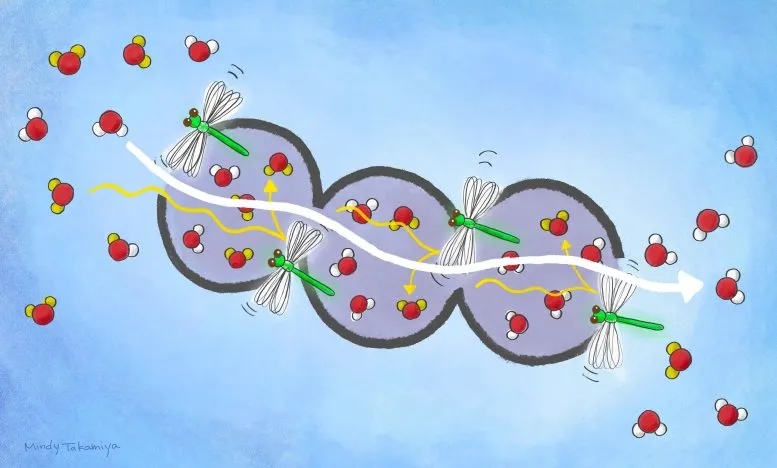博文
突破性材料在室温下从正常水中分离重水
||
突破性材料在室温下从正常水中分离重水
诸平
据日本京都大学(Kyoto University)2022年12月28日报道,中日研究人员合作,实现了突破性材料在室温下从正常水中分离重水(Breakthrough Material Separates Heavy Water From Normal Water at Room Temperature)。上述图示是由京都大学细胞材料科学研究所(Kyoto University’s Institute for Cell-Material Sciences简称iCeMS)提供,将蜻蜓形状的门分子(dragonfly-shaped gate molecules)加入到PCP/MOFs中,使其从重水中分离的效率提高了100倍。由于它们的性质相似,重水一直难以分离。多孔材料中的翻转作用促进了正常水的通过,使其与重水分离。
日本京都大学细胞材料科学研究所(iCeMS)的北川进(Susumu Kitagawa)和中国华南理工大学(South China University of Technology, Guangzhou, China)的顾成(Cheng Gu)领导的研究小组制造了一种材料,可以在室温下有效地将重水从正常水中分离出来。到目前为止,这个过程是非常困难和能源密集型的。这一发现对涉及使用同一分子的不同形式的工业过程——甚至是生物过程——都有影响。相关研究结果于2022年11月9日已经在《自然》(Nature)杂志网站发表——Yan Su, Ken-ichi Otake, Jia-Jia Zheng, Satoshi Horike, Susumu Kitagawa, Cheng Gu. Separating water isotopologues using diffusion-regulatory porous materials. Nature, Published: 09 November 2022. Volume 611, Pages 289–294. DOI: 10.1038/s41586-022-05310-y. https://www.nature.com/articles/s41586-022-05310-y
同位素是具有相同质子数而中子数不同的的元素,同位素异数体(Isotopologues)是具有相同化学式的分子,其原子以类似的排列方式结合,但至少其中一个原子的中子数与母分子不同。例如,一个水分子(H2O)由一个氧原子和两个氢原子组成。每个氢原子的原子核都含有一个质子,没有中子。另一方面,在重水(D2O)中,氘(D)原子是氢同位素,其核包含一个质子和一个中子。重水在核反应堆、医学成像和生物研究中有应用。
材料科学家顾成解释说:“水同位素异数体(Water isotopologues)是最难分离的,因为它们的性质非常相似。我们的工作为使用吸附-分离方法分离水同素异形体提供了前所未有的机制。”
顾成和化学家北川进及其同事将他们的分离技术建立在一种铜基多孔配位聚合物(copper-based porous coordination polymer简称PCP)上。多孔配位聚合物(PCP)是由金属节点组成的多孔晶体材料,由有机连接剂连接。该团队测试了两种由不同类型的连接剂制成的PCP。
使它们的PCP对同位素异数体分离特别重要的是,当适度加热时,连接剂会翻转。这种翻转动作就像一扇门,允许分子从PCP中的一个“笼子”进入另一个“笼子”。当材料冷却时,运动受阻。
当科学家们将他们的“触发器动态晶体(flip-flop dynamic crystals)”暴露在含有正常、重水和半重水混合物的蒸汽中,然后稍微加热它,它们吸附正常水的速度比其他两种同位素异数体(isotopologues)快得多。关键的是,这一过程发生在室温范围内。
北川进说:“在我们的工作中,水同位素异数体的吸附分离大大优于传统方法,因为在室温操作下具有非常高的选择性。我们乐观地认为,在我们的工作指导下,新材料将被开发出来,以分离其他同位素异数体。”
此研究工作得到了中国国家自然科学基金(National Natural Science Foundation of China: grant no. 21975078)、中国广东省基础与应用基础研究基金(Guangdong Basic and Applied Basic Research Foundation: grant no. 2021A1515010311)、广东省自然科学基金项目(Natural Science Foundation of Guangdong Province: grant no. 2019B030301003)、111计划(the 111 Project: grant no. BP0618009)、中国国家留学基金委提供的奖学金(China Scholarship Council: grant no. 202006150059)以及日本科学振兴协会(Japan Society of the Promotion of Science简称JSPS)的KAKENHI科学研究资助(KAKENHI Grant-in-Aid for Scientific Research (S): grant nos. JP18H05262/JP22H05005 from the JSPS)的支持。
上述介绍,仅供参考。欲了解更多信息,敬请注意浏览原文或者相关报道。
The discovery of a method to separate isotopologues, molecular entities that differ in only isotopic composition1, is fundamentally and technologically essential but remains challenging2,3. Water isotopologues, which are very important in biological processes, industry, medical care, etc. are among the most difficult isotopologue pairs to separate because of their very similar physicochemical properties and chemical exchange equilibrium. Herein, we report efficient separation of water isotopologues at room temperature by constructing two porous coordination polymers (PCPs, or metal–organic frameworks) in which flip-flop molecular motions within the frameworks provide diffusion-regulatory functionality. Guest traffic is regulated by the local motions of dynamic gates on contracted pore apertures, thereby amplifying the slight differences in the diffusion rates of water isotopologues. Significant temperature-responsive adsorption occurs on both PCPs: H2O vapour is preferentially adsorbed into the PCPs, with substantially increased uptake compared to that of D2O vapour, facilitating kinetics-based vapour separation of H2O/HDO/D2O ternary mixtures with high H2O separation factors of around 210 at room temperature.
https://wap.sciencenet.cn/blog-212210-1369967.html
上一篇:科学家们发现了具有抗癌潜力的独特肽
下一篇:挑战过去的理论——科学家在线虫中发现了一种众所周知的人类蛋白质的同系物
